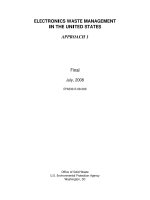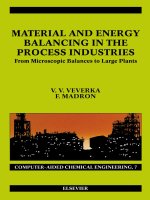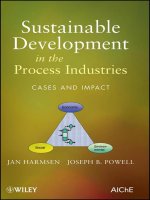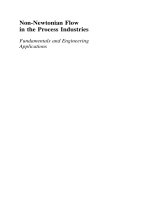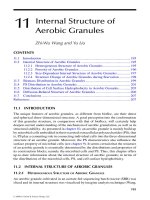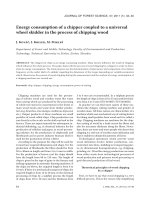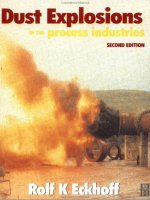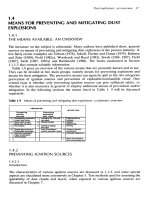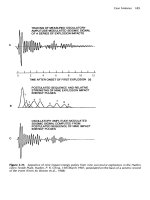Waste Treatment in the Process Industries - Chapter 11 pptx
Bạn đang xem bản rút gọn của tài liệu. Xem và tải ngay bản đầy đủ của tài liệu tại đây (914.32 KB, 45 trang )
11
Treatment of Pesticide Industry Wastes
Joseph M. Wong
Black & Veatch, Concord, California, U.S.A.
11.1 INTRODUCTION
Pesticides are chemical or biological substances intended to control weeds, insects, fungi,
rodents, bacteria, and other pests. They protect food crops and livestock, control household
pests, promote agricultural productivity, and protect public health. The importance of pesticides
to modern society can be summarized by a statement made by Norman E. Borlaug, the 1970
Nobel Peace Prize winner: “Let’s get our priorities in perspective. We must feed ourselves and
protect ourselves against the health hazards of the world. To do that, we must have agricultural
chemicals. Without them, the world population will starve” [1].
However, the widespread use of pesticides has also caused significant environmental
pollution problems. Examples of these include the biological concentration of persistent
pesticides (e.g., DDT) in food chains and contamination of surface and groundwater used for
drinking sources. Because they can affect living organisms, pesticides are highly regulated in the
United States to ensure that their use will be safe for humans and the environment. Recently, the
National Research Council’s Committee on the Future Role of Pesticides in U.S. Agriculture
conducted a comprehensive study and concluded that although they can cause environmental
problems, chemical pesticides will continue to play a role in pest management for the
foreseeable future. In many situations, the benefits of pesticide use are high relative to risks or
there are no practical alternatives [2].
This chapter deals with the characterization, environmental regulations, and treatment and
disposal of liquid wastes generated from the pesticide industry.
11.2 THE PESTICIDE INDUSTRY
The pesticide industry is an important part of the economy. Worldwide and U.S. pesticide sales
in 1990 were expected to reach more than $20 billion and $6 billion, respectively (Chemical
Week, January 3, 1990). Usually the highest usage of pesticides is in agriculture, accounting for
about 80% of production [3]. Agricultural pesticide use in the United States averaged 1.2 billion
pounds of ingredient in 1997, and was associated with expenditures exceeding $11.9 billion.
This use involved over 20,700 products and more than 890 active ingredients [2]. Household and
garden pesticide uses are other significant markets. The United States constituted about 40% of
499
© 2006 by Taylor & Francis Group, LLC
the world market for household pesticides, with annual sales exceeding $1 billion in 2002 [4].
China is the second largest national market with over $580 million of household insecticides
purchased each year [5]. The United States also dominates the world market for garden
pesticides with sales of over $1.5 billion per year. The United Kingdom is a distant second with
sales of $155 million [5].
Pesticides are classified according to the pests they control. Table 1 lists the various
pesticides and other classes of chemical compounds not commonly considered pesticides
but included among the pesticides as defined by U.S. federal and state laws [1]. The four most
widely used types of pesticides are: (a) insecticides, (b) herbicides, (c) fungicides, and
(d) rodenticides [6].
The major components of the pesticide industry include manufacturing and formulation/
packaging [7]. During manufacture, specific technical grade chemicals are made. Formulating/
packaging plants blend these chemicals with other active or inactive ingredients to achieve the
endproducts’ desired effects, and then package the finished pesticides into marketable
containers. A brief overview of these sectors of the industry follows.
Table 1 Pesticide Classes and Their Uses
Pesticide class Function
Acaricide Kills mites
Algicide Kills algae
Avicide Kills or repels birds
Bactericide Kills bacteria
Fungicide Kills fungi
Herbicide Kills weeds
Insecticide Kills insects
Larvicide Kills larvae (usually mosquito)
Miticide Kills mites
Molluscicide Kills snails and slugs (may include oysters, clams, mussels)
Nematicide Kills nematodes
Ovicide Destroys eggs
Pediculicide Kills lice (head, body, crab)
Piscicide Kills fish
Predicide Kills predators (coyotes, usually)
Rodenticide Kills rodents
Silvicide Kills trees and brush
Slimicide Kills slimes
Termiticide Kills termites
Chemicals classed as pesticides not bearing the -cide suffix:
Attractant Attracts insects
Chemosterilant Sterilizes insects or pest vertebrates (birds, rodents)
Defoliant Removes leaves
Desiccant Speeds drying of plants
Disinfectant Destroys or inactivates harmful microorganisms
Growth regulator Stimulates or retards growth of plants or insects
Pheromone Attracts insects or vertebrates
Repellent Repels insects, mites and ticks, or pest vertebrates
(dogs, rabbits, deer, birds)
Source: Ref. 1
500 Wong
© 2006 by Taylor & Francis Group, LLC
11.2.1 Pesticide Manufacturing
There are more than 100 major pesticide manufacturing plants in the United States. Figure 1
presents the geographical locations of these plants [7]. Specific pesticide manufacturing
operations are usually unique and are characteristic only of a given facility.
Almost all pesticides are organic compounds that contain active ingredients for specific
applications. Based on 500 individual pesticides of commercial importance and perhaps as many
as 34,000 distinct major formulated products, pesticide products can be divided into six major
groups [8]:
1. Halogenated organic.
2. Organophosphorus.
3. Organonitrogen.
4. Metallo-organic.
5. Botanical and microbiological.
6. Miscellaneous (not covered in the preceding groups).
Plants that manufacture pesticides with active ingredients use diverse manufacturing
processes, including synthesis, separation, recovery, purification, and product finishing such as
drying [9].
Chemical synthesis can include chlorination, alkylation, nitration, and many other
substitution reactions. Separation processes include filtration, decantation, extraction, and
centrifugation. Recovery and purification are used to reclaim solvents or excess reactants as well
as to purify intermediates and final products. Evaporation and distillation are common recovery
and purification processes. Product finishing may involve blending, dilution, pelletizing,
packaging, and canning. Examples of production facilities for three groups of pesticides follow.
Halogenated Aliphatic Acids
Figure 2 shows a simplified process flow diagram for halogenated aliphatic acid production
facilities [8]. Halogenated aliphatic acids include chlorinated aliphatic acids and their salts, for
example, TCA, Dalapon, and Fenac herbicides. Chlorinated aliphatic acids can be prepared by
nitric acid oxidation of chloral (TCA) or by direct chlorination of the acid. The acids can be sold
as mono- or dichloro acids, or neutralized to an aqueous solution with caustic soda. The
neutralized solution is generally fed to a dryer from which the powdered product is packaged.
As shown on Figure 2, wastewaters potentially produced during the manufacture of
halogenated aliphatic acids include the following:
. vent gas scrubber water from the caustic soda scrubber;
. wastewater from the chlorinator (reactor);
. excess mother liquor from the centrifuges;
. process area cleanup wastes;
. scrubber water from dryer units;
. washwater from equipment cleanout.
Nitro Compounds
This family of organonitrogen pesticides includes the nitrophenols and their salts, for example,
Dinoseb and the substituted dinitroanilines, trifluralin, and nitralin. Figure 3 shows a typical
commercial process for the production of a dinitroaniline herbicide [8]. In this example, a
chloroaromatic is charged to a nitrator with cyclic acid and fuming nitric acid. The crude product
is then cooled to settle out spent acid, which can be recovered and recycled. Oxides of nitrogen
Treatment of Pesticide Industry Wastes 501
© 2006 by Taylor & Francis Group, LLC
Figure 1 Geographical distribution of major pesticide manufacturers in the United States. Most of the plants are located in the eastern half of the continent
(from Ref. 7).
502 Wong
© 2006 by Taylor & Francis Group, LLC
Figure 2 General process flow diagram for halogerated aliphatic acid production facilities. Major processes for pesticide production,
including chlorination, cooling, crystallization, centrifying, and drying. The salt of the pesticide is produced by another route (from Ref. 8).
Treatment of Pesticide Industry Wastes 503
© 2006 by Taylor & Francis Group, LLC
Figure 3 General process flow diagram for nitro-type pesticides. Major processes for pesticide production are mononitration, dinitration, filtration, amination, filtering,
and vacuum distillation (from Ref. 8).
504 Wong
© 2006 by Taylor & Francis Group, LLC
are vented and caustic scrubbed. The mononitrated product is then charged continuously to
another nitrator containing 100% sulfuric acid and fuming nitric acid at an elevated temperature.
The dinitro product is then cooled and filtered (the spent acid liquor is recoverable), the
cake is washed with water, and the resulting washwater is sent to the wastewater treatment plant.
The dinitro compound is then dissolved in an appropriate solvent and added to the amination
reactor with water and soda ash. An amine is then reacted with the dinitro compound. The crude
product is passed through a filter press and decanter and finally vacuum distilled. The saltwater
layer from the decanter is discharged for treatment. The solvent fraction can be recycled to the
reactor, and vacuum exhausts are caustic scrubbed. Still bottoms are generally incinerated.
Wastewaters potentially generated during the manufacture of the nitro family of pesticides
include the following:
. aqueous wastes from the filter and the decanter;
. distillation vacuum exhaust scrubber wastes;
. caustic scrubber wastewaters;
. periodic kettle cleanout wastes;
. production area washdowns.
Metallo-Organic Pesticides
Metallo-organic active ingredients mean organic active ingredients containing one or more
metallic atoms, such as arsenic, mercury, copper, and cadmium, in the structure. Figure 4 shows
a general process flow diagram for arsenic-type metallo-organic pesticide production [8].
Monosodium acid methanearsenate (MSMA) is the most widely produced organoarsenic
herbicide in this group.
The first step of the process is performed in a separate, dedicated building. The drums of
arsenic trioxide are opened in an air-evacuated chamber and automatically dumped into 50%
caustic soda. A dust collection system is used. The drums are carefully washed with water, the
washwater is added to the reaction mixture, and the drums are crushed and sold as scrap metal.
The intermediate sodium arsenite is obtained as a 25% solution and is stored in large tanks prior
to further reaction. In the next step, the 25% sodium arsenite is treated with methyl chloride to
produce the disodium salt DSMA (disodium methanearsenate, hexahydrate). This DSMA can be
sold as a herbicide; however, it is more generally converted to MSMA, which has more
favorable application properties [8].
To obtain MSMA, the DSMA solution is partially acidified with sulfuric acid and the
resulting solution concentrated by evaporation. As the aqueous solution is being concentrated, a
mixture of sodium sulfate and sodium chloride precipitates out (about 0.5 kg per 100 kg of active
ingredient). These salts are a troublesome disposal problem because they are contaminated with
arsenic. The salts are removed by centrifugation, washed in a multistage, countercurrent washing
cycle, and then disposed of in an approved landfill.
Methanol, a side product of methyl chloride hydrolysis, can be recovered and reused. In
addition, recovered water is recycled. The products are formulated on site as solutions and are
shipped in 1 to 30 gallon containers.
Wastewaters that can be generated from the production of these pesticides include the
following:
. spillage from drum washing operations;
. washwater from product purification steps;
. scrub water from the vent gas scrubber unit;
. process wastewater;
Treatment of Pesticide Industry Wastes 505
© 2006 by Taylor & Francis Group, LLC
Figure 4 General process flow diagram for arsenic-type metallo-organic production. Sodium arsenate is formed in the first reactor, disodium
methanearsenate (DSMA) in the second reactor; DSMA is purified as a product or further changed to monosodium methanearsenate (MSMA) by
acidification and purified (from Ref. 8).
506 Wong
© 2006 by Taylor & Francis Group, LLC
. area washdowns;
. equipment cleanout wastes.
11.2.2 Pesticide Formulating/Packaging
After a pesticide is manufactured in its relatively pure form (the technical grade material) the
next step is formulation – processing a pesticide compound into liquids, granules, dusts, and
powders to improve its properties of storage, handling, application, effectiveness, or safety [9].
The technical grade material may be formulated by its manufacturer or sold to a formulator/
packager.
In the United States, there are more than a thousand pesticide formulating/packaging
plants covering a broad range of formulations [7]. Many small firms have only one product
registration, and produce only a few hundred pounds of formulated pesticides each year.
However, USEPA [7] identified one plant operating in the range of 100 million pounds of
formulated product per year. The approximate production distribution of formulators/packagers
is presented in Table 2 [7].
The most important unit operations involved in formulation are dry mixing and grinding of
solids, dissolving solids, and blending [8]. Formulation systems are virtually all batch-mixing
operations. The units may be completely enclosed within a building or may be in the open,
depending primarily on the geographical location of the plant. Production units representative of
the liquid and solid formulation/packaging equipment in use as well as wastewater generation
are described in the following.
Liquid Formulation Units
A typical liquid formulation unit is depicted in Fig. 5 [8]. Until it is needed, technical grade
pesticide is usually stored in its original shipping container in the warehouse section of the plant.
When this material is received in bulk, however, it is transferred to holding tanks for storage.
Batch-mixing tanks are frequently open-top vessels with a standard agitator and may or
may not be equipped with a heating/cooling system. When solid technical grade material is
used, a melt tank is used before this solid material is added to the mix tank. Solvents are normally
stored in bulk tanks and are either metered into the mix tank or are determined by measuring the
tank level. Necessary blending agents (emulsifiers, synergists, etc.) are added directly. From the
mix tank, the formulated material is frequently pumped to a holding tank before being put into
containers for shipment. Before packaging, many liquid formulations must be filtered by
conventional cartridge filters or equivalent polishing filters.
Air pollution control equipment used on liquid formulation units typically involves
exhaust systems at all potential sources of emission. Storage and holding tanks, mix tanks, and
Table 2 Formulator/Packager Production
Distribution
Production
(million lb/year)
Formulator/
Packagers (%)
,0.5 24
.0.5 to ,5.0 41
.5.0 to ,50 35
Total 100
Source: Ref. 7.
Treatment of Pesticide Industry Wastes 507
© 2006 by Taylor & Francis Group, LLC
Figure 5 Liquid formulation unit. Technical grade pesticide products are blended with solvents and emulsifiers or
other agents in a mix tank. Formulated products are filtered before packaging (from Ref. 8).
508 Wong
© 2006 by Taylor & Francis Group, LLC
container-filling lines are normally provided with an exhaust connection or hood to remove any
vapors. The exhaust from the system normally discharges to a scrubber system or to the
atmosphere.
Dry Formulation Units
Dry products can include dusts, powders, and granules. Dusts and powders are manufactured by
mixing technical grade material with the appropriate inert carrier and grinding the mixture to
obtain the correct particle size. Several rotary or ribbon blender-type mixers mix the product.
Figure 6 shows a typical dry formulation unit for pesticides [8].
Baghouse systems efficiently control particulate emissions from grinding and blending
processes. Vents from feed hoppers, crushers, pulverizers, blenders, mills, and cyclones are
typically routed to baghouses for product recovery. This method is preferable to using wet
scrubbers. However, even scrubber effluent can be largely eliminated by recirculation.
Granules are formulated in systems similar to the mixing sections of dust plants. The
active ingredient is adsorbed onto a sized, granular carrier such as clay or a botanical material.
This is accomplished in various capacity mixers that generally resemble cement mixers. If the
technical grade material is a liquid, it can be sprayed directly onto the granules. Solid material is
usually melted or dissolved in a solvent to provide adequate dispersion on the granules.
Screening to remove fines is the last step prior to intermediate storage before packaging.
Packaging and Storage
Packaging the finished pesticide into a marketable container is the last operation conducted at a
formulation plant. This operation is usually carried out in conventional filling and packaging
units. By moving from one unit to another, the same liquid filling line is frequently used to fill
products from several formulation units. Packages of almost every size and type are used,
including 1, 2, and 5 gallon cans, 30 and 55 gallon drums, glass bottles, bags, cartons, and plastic
jugs.
Aerosol products (for home use) undergo leak testing in a heated water bath to comply
with U.S. Department of Transportation regulations. This water bath also serves as a quality
control checkpoint for leaks. Bath water must be kept clean for inspection.
Generally, onsite storage is minimized. The storage facility is often a building completely
separate from the formulation and filling operation or is at least located in the same building
but separate from the formulation units to avoid contamination and other problems. Technical
grade material, except for bulk shipments, is usually stored in a special section of the product
storage area.
Wastewater Sources
In pesticide formulating/packaging plants, wastewaters can be generated at several sources,
including the following [8]:
. formulation equipment cleanup;
. spill washdown;
. drum washing;
. air pollution control devices;
. area runoff;
. laboratory drains.
Treatment of Pesticide Industry Wastes 509
© 2006 by Taylor & Francis Group, LLC
The major source of contaminated wastewater from formulation plants is equipment
cleanup. Formulation lines, including filling equipment, must be cleaned periodically to prevent
cross-contamination of product. Sometimes equipment is washed with formula solvent and
rinsed with water. Hence, this waste may contain pesticide ingredients as well as solvents.
Figure 6 Dry formulation unit. Technical grade products are ground and mixed with appropriate inert
materials; the premixed material is further blended with more inert materials and wetting agents in several
steps to obtain the correct particle size (from Ref. 8).
510 Wong
© 2006 by Taylor & Francis Group, LLC
For housekeeping purposes, most formulators clean buildings that house formulation units
on a routine basis. Prior to washdown, as much dust, dirt, and so on as possible is swept and
vacuumed. The washdown wastewater, which generally contains pesticide ingredients, is
normally contained within the building and is disposed of in whatever manner is used for other
contaminated wastewater.
A few formulation plants process used pesticide drums so they can be sold to a drum
reconditioner or reused by the formulator for appropriate products, or simply to decontaminate
the drums before they are disposed of. Drum-washing procedures range from a single rinse with
a small volume of caustic solution or water to complete decontamination and reconditioning
processes. Hence, drum-washing wastewater usually contains caustic solution as well as washed
pesticide ingredients in the drums.
Water-scrubbing devices are often used to control emission to the air. Most of these
devices generate wastewater streams that are potentially contaminated with pesticide
ingredients. Although the quantity of water in the system is high – about 20 gallons per
1000 cfm – water consumption is kept low by a recycle –sludge removal system.
Natural runoff at formulating/packaging plants, if not properly handled, can become a
major factor in the operation of wastewater systems simply because of the relatively high flow
and because normal plant wastewater volumes are generally extremely low. Isolation of runoff
from contaminated process areas or wastewaters, however, eliminates its potential for becoming
significantly contaminated with pesticide ingredients. Hence, the content of area runoff depends
on the degree of weather protection and area isolation. Modern stormwater pollution prevention
regulations in the United States have virtually eliminated this pollution source.
Most of the larger formulation plants have some type of control laboratory on site.
Wastewater from the control laboratories relative to the production operations can range from
an insignificantly small, slightly contaminated stream to a rather concentrated source of
contamination. In many cases, this stream can be discharged into the sanitary sewer. Larger,
more highly contaminated streams, however, must be treated along with other contaminated
wastewaters.
11.3 WASTE CHARACTERISTICS
Wastewater sources from pesticide manufacturing and formulating/packaging facilities have
been described in the previous section. This section discusses wastewater quality and quantity.
11.3.1 Pesticide Manufacturing
Because of the variety and uniqueness of pesticide manufacturing processes and operations, the
flow and characteristics of wastewater generated from production plants vary broadly. In 1978,
1979, 1980, 1982, and 1984, the USEPA conducted surveys to obtain basic data concerning
manufacturing, disposal, and treatment as well as to identify potential sources of priority
pollutants in pesticide manufacturers [7]. The results of these surveys and USEPA’s
interpretations and evaluations are summarized in the following.
Wastewater Flows
Based on survey results from individual plants, USEPA determined the amount of flow per unit
of pesticide production (gal/1000 lb) and the amount of flow (million gallons per day, or MGD)
at these plants.
Treatment of Pesticide Industry Wastes 511
© 2006 by Taylor & Francis Group, LLC
Figure 7 presents a probability plot of the flow ratio (gal/1000 lb) for 269 of the 327
pesticide process areas for which data were available [7]. Significant information in this
figure shows that 11% of all pesticide processes have no flow, 50% of all pesticide processes
have flows equal to or less than 1000 gal/1000 lb, and 84% have flows equal to or less than
4500 gal/1000 lb.
Figure 8 presents a probability plot of pesticide wastewater flows (MGD) at individual
plants [7]. This figure shows that 50% of all plants have flows less than 0.01 MGD, and that
virtually all plants (98%) have flows less than 1.0 MGD.
Wastewater Constituents
Because of the nature of pesticides and their components, wastewaters generated from
manufacturing plants usually contain toxic (e.g., toxic priority pollutants as defined by USEPA)
and conventional pollutants. Based on the results of the surveys and process evaluations, USEPA
determined the pollutants or groups of pollutants likely to be present in raw wastewater from
these facilities. The agency also selected raw waste loads for these pollutants in order to design
treatment and control technologies. The approach taken was to design for the removal of
maximum priority pollutant raw waste concentrations as reported in the surveys. Table 3
presents the summary of these raw waste load design levels [7].
The pollutants or groups of pollutants likely to be present in raw wastewater include
volatile aromatics, halomethanes, cyanides, haloethers, phenols, polynuclear aromatics, heavy
Figure 7 Probability plot of pesticide product flow ratios. Of pesticide production processes, 11% have
no flow, 50% have flows less than 1000 gal/1000 lb; 84% have flows less than 4500 gal/1000 lb (from
Ref. 7).
512 Wong
© 2006 by Taylor & Francis Group, LLC
metals, chlorinated ethanes and ethylenes, nitrosamines, phthalates, dichloropropane and
dichloropropene, pesticides, dienes, TCDD, and other common constituents such as BOD, COD,
and TSS. The sources and significance of these pollutants are briefly discussed [7].
Volatile Aromatics
Benzene and its derivatives are used widely throughout the chemical industry as solvents and
raw materials. Mono-, di-, and trichlorobenzenes are used directly as pesticides for their
insecticidal and fungicidal properties. Benzene, toluene, and chlorobenzene are used as raw
materials in the synthesis of at least 15 pesticides, although their main use is as a carrier solvent
in 76 processes. Additional priority pollutant aromatics and chlorinated aromatics exist as
impurities or as reaction byproducts because of the reactions of the basic raw materials and
solvent compounds.
Halomethanes
Halomethanes, including methylene chloride, chloroform, and carbon tetrachloride (di-, tri-, and
tetrachloromethane, respectively), are used mainly as raw materials and solvents in
approximately 28 pesticide processes. Bromomethanes can be expected in at least five
pesticides as raw materials, byproducts, or impurities and in the case of methyl bromide, can
function as a fumigant.
Figure 8 Probability plot of pesticide product wastewater flows. Of pesticide manufacturing plants, 50%
have flows less than 0.01 MGD; 98% have flows less than 1.0 MGD (from Ref. 7).
Treatment of Pesticide Industry Wastes 513
© 2006 by Taylor & Francis Group, LLC
Cyanide
Cyanide is a known or suspected pollutant in approximately 24 pesticide processes. The primary
raw materials that favor the generation of cyanides as either byproducts or impurities are
cyanamides, cyanates, thiocyanates, and cyanuric chloride. Cyanuric chloride is used
exclusively in the manufacture of triazine pesticides.
Haloethers
Five compounds classified as priority pollutants contain an ether moiety and halogen atoms
attached to the aryl and alkyl groups. Five pesticides are suspected to contain at least one
compound from this class. Bis(2-chloroethyl) ether (BCEE) is used as a raw material in two
pesticides; BCEE itself functions as a fungicide or bactericide in certain applications. In the
other three pesticides, the ethers are suspected to be present as raw material impurities.
Phenols
Phenols are compounds having the hydroxyl (OH) group attached directly to an aromatic ring.
Phenols commonly found in pesticide wastewaters include chlorophenols, nitrophenols, and
Table 3 Summary of Raw Waste Load Design Levels.
Pollutant group
Design level
(mg/L)
Detected pesticide
wastewaters at
design level
a
(%)
Volatile aromatics 127–293,000 24
Halomethanes 122–2,600 23
Cyanides 5,503 6.0
Haloethers 0.582 17
Phenols 100–42,000 45
Nitro-substituted aromatics ND
b
100
Polynuclear aromatics 1.06–1.2 25
Metals
Copper 4,500 17
Zinc 247 100
Chlorinated ethanes and ethylenes 98–10,000 18
Nitrosamines 1.96 100
Phthalates ND 100
Dichloropropane and dichloropropene ND 100
Pesticides 10–11,200 45
Dienes 2,500– 15,000 50
TCDD 0.022 100
Miscellaneous N/A
c
N/A
PCBs N/AN/A
Benzidine N/AN/A
BOD 1,470 33
COD 3,886 45
TSS 266 14
a
Remainder of known pesticide wastewaters are below design level prior to biological oxidation.
b
ND ¼ not detected.
c
NA ¼ not applicable.
Source: Ref. 7.
514 Wong
© 2006 by Taylor & Francis Group, LLC
methylphenols (cresols). These compounds may be found throughout the pesticide industry as
raw materials, impurities in raw materials, or as byproducts of reactions using related
compounds such as chlorobenzenes. The presence of nitrated phenols is expected in six
pesticides. Methylated phenols are not expected to be significant because they are not used as
raw materials, but they may appear as impurities of reaction from one pesticide because of using
4-methylthio-m-cresol as a raw material.
Polynuclear Aromatics
Seventeen priority pollutant compounds can be classified as polynuclear aromatics (PNA).
These compounds consist of two or more benzene rings that share a pair of carbon atoms.
They are all derived from coal tar, with naphthalene being the largest constituent. Naphthalene
derivatives such as alpha-naphthylamine and alpha-naphthol are used in some pesticide pro-
cesses; therefore, naphthalene is by far the most prevalent PNA priority pollutant in the industry.
Acenaphthene, anthracene, fluorene, fluoranthene, and phenathrene are found as raw material
impurities. Acenaphthene is found in one pesticide process as a raw material. The remaining ten
PNAs are not suspected to be present in pesticide processes.
Heavy Metals
In the pesticide industry, metals are used principally as catalysts or as raw materials that are
incorporated into the active ingredients, for example, metallo-organic pesticides. Priority
pollutant metals commonly incorporated into metallo-organic pesticides include arsenic,
cadmium, copper, and mercury. For metals not incorporated into the active ingredients, copper is
found or suspected in wastewaters from at least eight pesticides, where it is used as a raw
material or catalyst; zinc becomes part of the technical grade pesticide in seven processes; and
mercury is used as a catalyst in one pesticide process. Nonpriority pollutant metals such as
manganese and tin are also used in pesticide processes.
Chlorinated Ethanes and Ethylenes
The chlorinated ethanes and ethylenes are used as solvents, cleaning agents, and intermediates.
Vinyl chloride (chloroethylene) is used in the production of plastic polyvinyl chloride (PVC).
In the pesticide industry, approximately 23 products are suspected to contain a member of this
group of priority pollutants. The main pollutants include 1,2-dichloroethane, which is used as a
solvent in seven pesticides and tetrachloroethylene, which is used as a solvent in two pesticides.
Nitrosamines
N-nitrosamines are a group of compounds characterized by a nitroso group (N55O) attached to
the nitrogen of an aromatic or aliphatic secondary amine. N-nitrosodi-N-propylamine is a
suspected reaction byproduct from the nitrosation of di-N-propylamine. Two pesticides are
suspected to contain some form of nitrosamines.
Phthalates
Phthalate esters are used widely as plasticizers in commercial polymers and plastic endproducts
such as PVC. One phthalate classified as a priority pollutant is suspected to be present in three
pesticide processes. Dimethyl phthalate is known to be a raw material in two products.
Treatment of Pesticide Industry Wastes 515
© 2006 by Taylor & Francis Group, LLC
Dichloropropane and Dichloropropene
1,3-Dichloropropene is a raw material in one pesticide. 1,3-Dichloropropene and the combined
pollutants 1,2-dichloropropane-1, 3-dichloropropene are pesticide products as well as priority
pollutants and function as insecticidal fumigants.
Priority Pollutant Pesticides
There are only 18 priority pollutants commonly classified as pesticides. Only two are still in
production: heptachlor and chlordane. Aldrin, dieldrin, and endrin aldehyde are suspected as
reaction byproducts in the endrin process. Heptachlor epoxide occurs as a reaction byproduct in
both chlordane and heptachlor manufacturing. DDD, DDE, and DDT can occur as a reaction
byproduct in the manufacture of endosulfan.
Dienes
Four manufactured pesticides and two pesticides currently not manufactured use a priority
pollutant diene as a raw material. The basic material for all six pesticides is hexa-
chlorocyclopentadiene (HCCPD). The priority pollutant hexachlorobutadiene is suspected to be
present in the pesticide wastewater because it is a byproduct of HCCPD synthesis and is used as
a solvent in manufacturing mirex.
TCDD
2,3,7,8-Tetrachlorodibenzo-p-dioxin (TCDD) is believed to be a byproduct in chemical
processing generated by a halophenol or chlorobenzene starting material. An intermediate
reaction will occur at an elevated temperature (equal to or greater than 1608C), an alkaline
condition, or in the presence of a free halogen. The end reaction results in either direct dioxin,
intermediate dioxin, or predioxin formation that will ultimately form dibenzo-p-dioxins [10].
TCDD is suspected in wastewaters from pesticide manufacture that uses such raw materials as
2,4,5-trichlorophenol (2,4,5-T) and 1,2,4,5-tetra-chlorobenzene, which are characteristic of
TCDD precursors. A TCDD level as high as 111 mg/L has been found in drums of waste from
the production of the pesticide 2,4,5-T.
Other Pollutants
The pesticide industry routinely monitors conventional and nonconventional pollutants in
manufacturing wastewaters. According to the USEPA surveys [7], chemical oxygen demand
(COD) concentrations ranged from 14.0 mg/L to 1,220,000 mg/L; Total organic carbon (TOC)
ranged from 53.2 mg/L to 79,800 mg/L; biochemical oxygen demand (BOD) ranged from
nondetected to 60,000 mg/L; and total suspended solids (TSS) ranged from 2.0 mg/Lto
4090 mg/L. Many other pollutants can be present in pesticide wastewaters that are not unique to
this industry, including pollutants such as ammonia, oil and grease, fluoride, and inorganic salts.
Nonpriority pollutant pesticides would naturally occur in their manufacturing wastewaters due
to imperfect separations.
11.3.2 Pesticide Formulating/Packaging
Washing and cleaning operations provide the principal sources of wastewater in formulating and
packaging operations. Because these primary sources are associated with cleanup of spills, leaks,
516 Wong
© 2006 by Taylor & Francis Group, LLC
area washdowns, and stormwater runoff, there is apparently no basis from which to correlate the
pollutants generated to the product made.
According to USEPA’s survey [8] of 71 pesticide formulating/packaging plants, 59
reported no generation of wastewater. For the plants that generated wastewater, neither the rate
of production nor the type of product formulated had a direct bearing on the quality or quantity
of wastewater generated. The three largest plants of a major pesticide formulator each generated
less than 5800 gal/day. Other plants generated from 5 to 1000 gal/day. The average flows
generated in formulating/packaging plants were between 50 and 1000 gal/day [11].
The pollutants contained in the wastewaters are expected to be similar to those from
manufacturing facilities. Pesticides and solvents are the principal pollutants of concern.
Although their volumes are small, the wastewaters from pesticide formulating/packaging plants
could be highly contaminated and toxic.
11.4 ENVIRONMENTAL REGULATIONS
Many federal and state regulations govern the registration, manufacture, transportation, sale,
use, and disposal of pesticides in the United States. Pesticides are regulated by the USEPA
primarily under the Federal Insecticide, Fungicide, and Rodenticide Act (FIFRA) and the
Federal Food, Drug, and Cosmetic Act (FDCA). The FIFRA requires pesticides to be registered
by USEPA and authorizes the agency to prescribe conditions for their use. The FDCA requires
the agency to establish maximum acceptable levels of pesticide residues in foods. The
transportation of hazardous pesticides is regulated by the Hazardous Materials Transportation
Act (HMTA). In addition, certain states such as California and Florida aggressively enforce their
own pesticide laws.
The disposal of pesticides and pesticide wastes is regulated by the Clean Air Act (CAA),
the Clean Water Act (CWA), the Resource Conservation and Recovery Act (RCRA), and the
Comprehensive Environmental Response, Compensation, and Liability Act (CERCLA). This
section deals with the regulations for liquid waste disposal, which is mainly under the CWA.
However, when the waste is disposed of as a hazardous waste, it is regulated by the RCRA.
11.4.1 Clean Water Act
The U.S. Congress enacted the Federal Water Pollution Control Act (FWPCA) in 1972. The act
was significantly amended in 1977 and has since become known as the CWA. It was again
amended by the Water Quality Act of 1987. The CWA applies to all industries that generate
wastewater discharges. Some of its provisions are particularly applicable to the pesticide
industry.
Effluent Guidelines for Pesticides
Under Section 304 of the CWA, USEPA was required to establish “effluent guidelines” for a
number of different industrial categories by specifying the effluent limits that must be met
by dischargers in each category. Two types of standards were required for each industry:
(a) effluent limitations that require the application of the best practicable control technology
(BPT) currently available, and (b) effluent limitations that require application of the best
available technology (BAT).
Effluent limitations reflecting BPT currently available for the pesticide manufacturing and
formulating industrial category were promulgated by USEPA on April 25, 1978 (43 Federal
Treatment of Pesticide Industry Wastes 517
© 2006 by Taylor & Francis Group, LLC
Regulation 17,785, 1978). The pesticide industry was divided into three subcategories under the
BPT regulations: (a) organic pesticide chemicals manufacturing, (b) metallo-organic pesticide
chemical manufacturing, and (c) pesticide chemicals formulating and packaging.
For the first subcategory, the rules limit the number of pounds or kilograms of COD, BOD,
TSS, and pesticide chemicals that a plant may discharge during any 1 day or any 30 consecutive
days. Table 4 presents the BPT effluent limitations for the organic pesticide chemicals
manufacturing subcategory (40 CFR pt. 455). For the second and third subcategories, the
regulations permit “no discharges of process wastewater pollutants into navigable waters.” The
BPT regulations are based on pesticide removal by hydrolysis or adsorption followed by
biological treatment [3].
The USEPA issued BAT regulations for the pesticide industry in October 1985 (50 Federal
Regulation 40701, 1985). However, four chemical companies and three chemical trade
organizations challenged these regulations in Chemical Specialties Manufacturers Association
vs. EPA, No. 86-8024 (11th Cir. July 25, 1986), modified (11th Cir. August 29, 1986). As a
result, the agency voluntarily withdrew its regulations and, on remand by the Eleventh Circuit,
agreed to initiate a new round of rule making on the pesticide industry standards (51 Federal
Regulation 44,911, 1986). The new regulations were later proposed by USEPA in 1992 [12] and
finalized in 1996 (61 FR 57551, No. 6, 1996). All of the updated effluent guidelines and
standards for the pesticide manufacturing and formulation industries are included in 40 CFR Part
455 – Pesticide Chemicals.
Pretreatment Standards for Pesticides
Section 306(b) of the CWA requires USEPA to promulgate pretreatment standards
applicable to the introduction of wastes from industry and other nondomestic sources into
publicly owned treatment works (POTWs). USEPA issued the General Pretreatment Regulations
on June 26, 1978, and amended these regulations several times in the following years (40 CFR
pt. 403).
The pretreatment standards for existing and new sources for the organic pesticide
chemicals manufacturing subcategory were promulgated on September 28, 1993 (58 Federal
Table 4 BPT
b
Effluent Limitations for Organic Pesticide Chemicals Manufacturing
Subcategory
Effluent characteristics
Maximum for
any 1 day
Average of daily values
for 30 consecutive days
shall not exceed
COD 13.000 9.0000
BOD
5
7.400 1.6000
TSS 6.100 1.8000
Organic pesticide chemicals 0.010 0.0018
pH (
0
)
a
(
0
)
Source: 40 CFR 455.22.
a
(
0
) Within the range 6.0– 9.0.
b
BPT, best practicable control technology currently available.
Note: For COD, BOD
5
, and TSS, metric units: Kilogram/1,000 kg of total organic active ingredients.
English units: Pound/1,000 lb of total organic active ingredients. For organic pesticide – metric units:
Kilogram/1,000 kg of organic pesticide chemicals. English units: Pound/1,000 lb of organic pesticide
chemicals.
518 Wong
© 2006 by Taylor & Francis Group, LLC
Register 50690). The main concern for this subcategory is the discharge of priority pollutants
into POTWs. Table 6 in 40 CFR Part 455 listed 24 priority pollutants with maximum daily and
maximum monthly discharge limitations. With the exception of cyanide and lead, all the priority
pollutants are organic compounds. Presently there are no pretreatment standards for the metallo-
organic pesticide chemicals manufacturing subcategory. The pretreatment standard for the
pesticide chemicals formulating and packaging subcategory is no discharge of process
wastewater pollutants to POTWs (40 CFR Part 455.46).
The general pretreatment regulations prohibit an industry or nondomestic source from
introducing pollutants that will pass through or interfere with the operation or performance of
POTWs [40 CFR Section 403.5(a)]. In addition, the CWA requires USEPA to establish
“categorical” pretreatment standards, which apply to existing or new industrial users in specific
categories (40 CFR Section 403.6). The discharge of wastewater from the pesticide industry to
POTWs will also be subject to the general discharge prohibitions against “pass through” and
“interference” with the POTWs. These pretreatment requirements are usually enforced by
POTWs, with approved pretreatment programs. As an example, Table 5 shows the general
Table 5 Industrial Waste Pretreatment Limits for a Publicly Owned
Treatment Works
Toxic substance
Maximum allowable
concentration (mg/L)
Aldehyde 5.0
Antimony 5.0
Arsenic 1.0
Barium 5.0
Beryllium 1.0
Boron 1.0
Cadmium 0.7
Chlorinated hydrocarbons including, but not
limited to, pesticides, herbicides, algaecides
Trace
Chromium, total 1.0
Copper 2.7
Cyanides 1.0
Fluorides 10.0
Formaldehydes 5.0
Lead 0.4
Manganese 0.5
Mercury 0.010
Methyl ethyl ketone and other water-insoluble
ketones
5.0
Nickel 2.6
Phenol and derivatives 30.0
Selenium 2.0
Silver 0.7
Sulfides 1.0
Toluene 5.0
Xylene 5.0
Zinc 2.6
pH, su 5.0 to 10.5
Source: City of San Jose (California) Municipal Code, 1988.
Treatment of Pesticide Industry Wastes 519
© 2006 by Taylor & Francis Group, LLC
industrial effluent limits established by the City of San Jose, CA (San Jose Municipal Code,
1988).
Toxic Pollutant Effluent Standards
Section 307 of the CWA requires USEPA to maintain and publish a list of toxic (priority)
pollutants, to establish effluent limitations for the BAT economically achievable for control of
such pollutants, and to designate the category or categories of sources to which the effluent
standards shall apply [3]. Effluent standards have been promulgated for the following toxic
pollutants: aldrin/dieldrin; DDT, DDD, and DDE; endrin; toxaphene; benzidine; and PCBs (40
CFR 129.4). These standards, which may be incorporated into National Pollutant Discharge
Elimination System (NPDES) permits, limit or prohibit the discharge of process wastes or other
discharge from manufacturing processes into navigable waters. For example, any discharge of
aldrin or dieldrin is prohibited for all manufacturers (40 CFR 129.100(b)(3)).
Water Quality-Based Limitations
In the United States, as control of conventional pollutants has been significantly achieved,
increased emphasis is being placed on reduction of toxic pollutants. The USEPA has developed a
water quality-based approach to achieve water quality where treatment control-based discharge
limits have proved to be insufficient [13].
The procedures for establishing effluent limitations for point sources discharging to a
water quality-based segment generally involves the use of some type of mathematical model or
allocation procedure to apportion the allowable loading of a particular toxicant to each discharge
in the segment. These allocations are generally made by the state regulatory agency and
reviewed, revised, and approved by the USEPA in accordance with Section 303 of the CWA.
To control the discharge of toxic pollutants in accordance with Section 304(1) of the
CWA, state and regional regulatory agencies may also establish general effluent limitations for a
particular water body. For example, Table 6 shows the discharge limits for toxic pollutants
Table 6 Effluent Limitations for Selected Toxic Pollutants
for Discharge to Surface Waters (All Values in mg/L)
Daily average
Shallow water Deep water
Arsenic 20 200
Cadmium 10 30
Chromium(VI) 11 110
Copper 20 200
Cyanide 25 25
Lead 5.6 56
Mercury 1 1
Nickel 7.1 71
Silver 2.3 23
Zinc 58 580
Phenols 500 500
PAHs 15 150
Source: Water Quality Control Plan, San Francisco Bay Basin, 1986.
520 Wong
© 2006 by Taylor & Francis Group, LLC
established by the San Francisco Bay Regional Water Quality Control Board in 1986. This
regional agency has also adopted biomonitoring and toxicity requirements for municipal and
industrial dischargers. Biomonitoring, or whole-effluent toxicity testing, has become a
requirement for most discharges in the United States. As of 1988, more than 6000 discharge
permits incorporated toxicity limits to protect against acute and chronic toxicity [13] and
practically all discharge permits in the United States have toxicity limits as of 2003.
When a discharge exceeds the toxicity limits, the discharger must conduct a toxicity
identification/reduction evaluation (TI/RE). A TI/RE is a site-specific investigation of the
effluent to identify the causative toxicants that may be eliminated or reduced, or treatment
methods that can reduce effluent toxicity.
11.4.2 Resource Conservation and Recovery Act
The Resource Conservation and Recovery Act (RCRA) was enacted in 1976 and was revised
substantially by the Hazardous and Solid Waste Amendment (HSWA) of 1984 (40 CFR pts.
260–280). The RCRA regulates the management of “solid wastes” that are “hazardous.” The
definition of “solid wastes” in these regulations generally encompasses all “discarded” materials
(including solid, liquid, semisolid, and contained gaseous materials) and many “secondary
materials” (e.g., spent solvents, byproducts) that are recycled or reused rather than discarded [3].
Products such as commercial pesticides are not ordinarily “solid wastes,” but they become solid
wastes if and when they are discarded or stored, treated, or transported prior to such disposal.
The “solid wastes” that are RCRA hazardous wastes are those either listed in 40 CFR pt.
261, or exhibit one of the four “characteristics” [ignitability, corrosivity, reactivity, and
“extraction procedure” (EP) toxicity] identified in Part 261 [a more stringent Toxicity
Characteristic Leaching Procedure (TCLP) replaced EP in 1986 (51 Federal Regulation 21,648
1986)]. Both the characteristics and the lists sweep many pesticides and pesticide wastes into the
RCRA regulatory program.
The USEPA has developed extensive lists of waste streams (40 CFR Sections 261.31,
261.32) and chemical products (40 CFR Section 261.33) that are considered hazardous wastes if
and when disposed of or intended for disposal. The waste streams listed in Sections 261.31 and
261.32 include numerous pesticide manufacturing and formulating process wastes. The lists of
commercial chemical products in Section 261.33 include two sublists; both include numerous
insecticides, herbicides, and other pesticides. The E List (Table 7) identifies pesticides and other
commercial chemicals regulated as “acutely hazardous wastes” when discarded. The F List
(Table 8) identifies pesticides that are regulated as toxic (hazardous) wastes when discarded.
Listed pesticides (formulated, manufacturing-use, and off-specification) are regulated as
hazardous wastes under the RCRA if they are discarded rather than used for their intended
purposes. State listings are often more extensive. Both onsite and offsite disposal options are
regulated under the RCRA. Onsite facilities that generate more than 1 kg/month of acutely
hazardous wastes in the RCRA E List or 1000 kg/month of any waste as defined in 40 CFR
261.31, 261.32, or 261.33 will require an RCRA hazardous waste permit for treatment or for
storage for more than 90 days. Offsite disposal must be handled by an RCRA-permitted facility.
11.5 CONTROL AND TREATMENT FOR PESTICIDE
MANUFACTURING WASTES
The management of wastes from pesticide manufacturing plants includes source control, in-
plant control/treatment, end-of-pipe treatment, and other control methods for concentrated
Treatment of Pesticide Industry Wastes 521
© 2006 by Taylor & Francis Group, LLC
wastes such as incineration. Source control can reduce the overall pollutant load that must be
treated in an end-of-pipe treatment system. In-plant control/treatment reduces or eliminates a
particular pollutant before it is diluted in the main wastewater stream, and may provide an
opportunity for material recovery. End-of-pipe treatment is the final stage for meeting regulatory
discharge requirements and protection of stream water quality. These and other control
techniques are discussed in more detail in the following sections.
11.5.1 Source Control
Source control and waste minimization can be extremely effective in reducing the costs for in-
plant controls and end-of-pipe treatment, and in some cases can eliminate the need for some
treatment units entirely. The first step is to prepare an inventory of the waste sources and
continuously monitor those sources for flow rates and contaminants. The next step is to develop
in-plant operating and equipment changes to reduce the amount of wastes. The following are
some of the techniques available for the pesticides manufacturing facilities.
Table 7 Pesticide Active Ingredients That Appear on the RCRA Acutely Hazardous Commercial
Products List (RCRA E List)
Acrolein Endrin
Aldicarb Famphur
Aldrin Fluoroacetamide
Allyl alcohol Heptachlor
Aluminum phosphide Hydrocyanic acid
4-Aminopyridine Hydrogen cyanide
Arsenic acid Methomyl
Arsenic pentoxide Alpha-naphthylthiourea (ANTU)
Arsenic trioxide Nicotine and salts
Calcium cyanide Octamethylpyrophosphoramide (OMPA, schradan)
Carbon disulfide Parathion
p-Chloroaniline Phenylmercuric acetate (PMA)
Cyanides (soluble cyanide salts) Phorate
Cyanogen Potassium cyanide
2-Cyclohexyl-4,6-dinitrophenol Propargyl alcohol
Dieldrin Sodium azide
0,0-Diethyl S-[2-ethylthio)ethyl]
phosphorodithioate (disulfoton, Di-Syston
w
)
Sodium cyanide
0,0-Diethyl 0-pyrazinyl phosphorothioate
(Zinophos
w
)
Sodium fluoroacetate
Dimethoate Strychnine and salts
0,0-Dimethyl 0-p-nitrophenyl phosphorothioate
(Methyl parathion)
0,0,0,0-tetraethyl dithiopyrophosphate (sulfotepp)
4,6-Dinitro-o-cresol and salts Tetraethyl pyrophosphate
4,6-Dinitro-o-cyclohexylphenol Thallium sulfate
2,4-Dinitrophenol Thiofanox
Dinoseb Toxaphene
Endosulfan Warfarin
Endothall Zinc phosphide
Note: There are currently no inert pesticide ingredients on the RCRA E List.
Source: 40 CFR 261.33(e).
522 Wong
© 2006 by Taylor & Francis Group, LLC
Table 8 Pesticides and Inert Pesticide Ingredients Contained on the RCRA Toxic Commercial Products
List (RCRA F List)
Active ingredients
Acetone Hexachlorobenzene
Acrylonitrile Hexachlorocyclopentadiene
Amitrole Hydrofluoric acid
Benzene Isobutyl alcohol
Bis(2-ethylhexyl) phthalate Lead acetate
Cacodylic acid Lindane
Carbon tetrachloride Maleic hydrazide
Chloral (hydrate) Mercury
Chlorodane, technical Methyl alcohol (methanol)
Chlorobenzene Methyl bromide
4-Chloro-m-cresol Methyl chloride
Chloroform 2,2
0
-Methylenebis (3,4,6-trichlorophenol)
(hexachlorophene)
o-Chlorophenol Methylene chloride
4-Chloro-o-toluidine hydrachloride Methyl ethyl ketone
Creosote 4-Methyl-2-pentanone (methyl isobutyl ketone)
Cresylic acid (cresols) Naphthalene
Cyclohexane Nitrobenzene
Cyclohexanone p-Nitrophenol
Decachlorooctahydro-1,3,4-metheno-2H-
cyclobuta[c,d]-pentalen-2-one (Kepone,
chlordecone)
Pentachloronitrobenzene (PCNB)
1,2-dibromo-3-chloropropane (DBCP) Pentachlorophenol
Dimbutyl phthalate Phenol
S-2,3-(Dichloroallyl diisopropylthiocarbamate)
(diallate, Avadex)
Phosphorodithionic acid, 0,0-diethyl, methyl
ester
o-Dichlorobenzene Propylene dichloride
p-Dichlorobenzene Pyridine
Dichlorodifluoromethane (Freon 12
w
) Resorcinol
3,5-Dichloro-N-(1,1-dimethyl-2-propyny1)
benzamide (pronamide, Kerb
w
)
Safrole
Dichloro diphenyl dichloroethane (DDD) Selenium disulfide
Dichloro diphenyl trichloroethane (DDT) 1,2,4,5-Tetrachlorobenzene
Dichloroethyl ether 1,1,2,2-Tetrachloroethane
2,4-Dichlorophenoxyacetic, salts and esters
(2,4-D)
2,3,4,6-Tetrachlorophenol
1,2-Dichloropropane Thiram
1,3-Dichloropropene (Telone) Toluene
Diethyl phthalate 1,1,1-Trichloroethane
Epichlorohydrin (1-chloro-2,3-epoxypropane) Trichloroethylene
Ethyl acetate Trichloromonofluoromethane (Freon 11
w
)
Ethyl 4,4
0
-dichlorobenzilate (chlorobenzilate) 2,4,5-Trichlorophenol
Ethylene dibromide (EDB) 2,4,6-Trichlorophenol
Ethylene dichloride 2,4,5-Trichlorophenoxyacetic acid (2,4,5-T)
Ethylene oxide 2,4,5-Trichlorophenoxypropionic acid (Silvex)
Formaldehyde Xylene
Furfural
(continues)
Treatment of Pesticide Industry Wastes 523
© 2006 by Taylor & Francis Group, LLC
